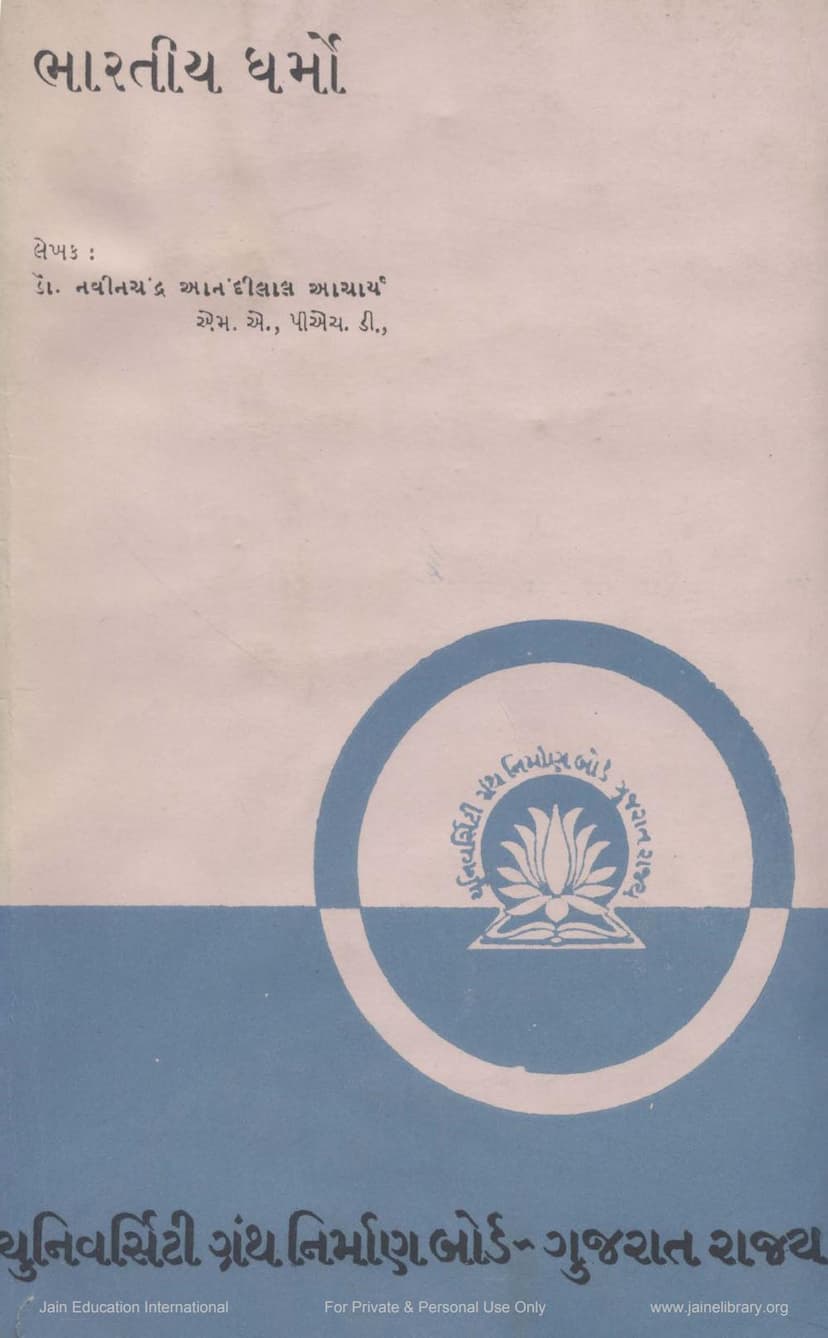Bharatiya Dharmo
Added to library: September 1, 2025

Summary
This book, "Bharatiya Dharmo" (Religions of India), authored by Dr. Navinchandra Anandilal Acharya, is published by the University Granth Nirman Board, Gujarat State. The book provides a comprehensive overview of the various religions prevalent in India, tracing their origins, development, core principles, prominent figures, scriptures, and their impact on Indian culture and society.
Key aspects covered in the book include:
- Introduction: The book begins by emphasizing the profound influence of religion on Indian culture, stating that religion is the soul of Indian civilization and that separating religion from culture is nearly impossible. It highlights India's openness to accepting knowledge from all sources, leading to the continuous evolution of its religious landscape.
- Definition of Dharma: The book delves into the meaning of "Dharma" as that which sustains and upholds, drawing from the Mahabharata's statement that "Dharma sustains, upholds, therefore it is called Dharma." It emphasizes Dharma as a driving force for the individual, society, nation, and the entire world, shaping character and guiding towards truth.
- Key Religions of India: The book systematically discusses major religions that have shaped India:
- Hinduism: Explored as the most ancient religion in India, detailing its gradual evolution from the Indus Valley Civilization, its various denominations (Shaivism, Vaishnavism, Shaktism), its scriptural basis (Vedas, Upanishads), and its core philosophies (Bhakti, Karma, and Gyan Margas). It outlines the development of Hinduism through different historical periods: Vedic Age, Smriti/Pauranic Age, Acharya Age, Sadhu-Sant Age, and the Modern Era of Reformation.
- Jainism: Presented as an ancient religion originating from the Shraman tradition, emphasizing its core principles of Ahimsa (non-violence), Satya (truth), Asteya (non-stealing), Brahmacharya (celibacy), and Aparigraha (non-possession). It details the Tirthankaras, the distinction between Shwetambara and Digambara sects, and the significance of the Three Jewels (Samyak Darshan, Samyak Gyan, Samyak Charitra). The book also touches upon the concept of karma and its influence.
- Buddhism: Introduced as another significant religion from the Shraman tradition, focusing on the life and teachings of Lord Buddha. It explains the Four Noble Truths and the Eightfold Path as the means to overcome suffering and attain Nirvana. The text also differentiates between the Hinayana and Mahayana schools of Buddhism and discusses the influence of Buddhist art and architecture.
- Sikhism: Traced back to Guru Nanak, the book highlights its genesis in the context of socio-religious conditions in Punjab during the medieval period. It emphasizes the core tenets of one God, the importance of the Guru, equality of all human beings, selfless service (seva), and the use of vernacular languages for religious discourse. The book details the lives and contributions of the ten Sikh Gurus and the significance of the Guru Granth Sahib.
- Islam: Discusses the arrival and spread of Islam in India, primarily through Arab traders and later through political conquest. It highlights the key principles of Islam, including the concept of Allah, the Prophet Muhammad, the Quran, and the Five Pillars of Islam (Shahada, Salat, Zakat, Sawm, and Hajj). The book also touches upon the influence of Sufism in India.
- Zoroastrianism (Jainism): Explains the history of the Parsi community in India, their migration from Persia due to persecution, and their settlement in Gujarat. It highlights their adherence to Zoroastrian principles, particularly the worship of Ahura Mazda, the importance of fire temples (Agiyari), and their cultural contributions.
- Christianity: Traces the introduction of Christianity to India from early centuries, its presence in South India, and its subsequent spread through European missionaries, particularly during the colonial era. It notes the establishment of churches, schools, and hospitals by Christian missionaries and the impact of Western education.
- Judaism: Briefly mentions the presence of Jewish communities in India, particularly in Kerala and Maharashtra, and their cultural assimilation while retaining their religious identity.
- Impact of Western Culture: The book dedicates a section to the influence of Western culture on Indian religions and society, noting the introduction of new ideas, educational systems, and the subsequent rise of reform movements. It also discusses the cultural differences between Eastern and Western civilizations and the ongoing process of their integration.
Overall, "Bharatiya Dharmo" aims to provide readers with a foundational understanding of the diverse religious traditions that have shaped India's rich cultural heritage. The author, Dr. Navinchandra A. Acharya, a retired professor with extensive experience in Indian culture, has drawn upon his academic background and published works to present this comprehensive study. The book is designed to be useful for students and anyone interested in the religious landscape of India.